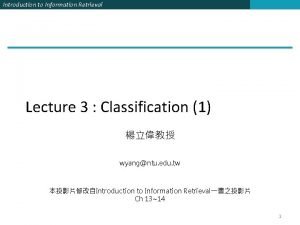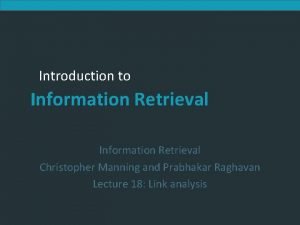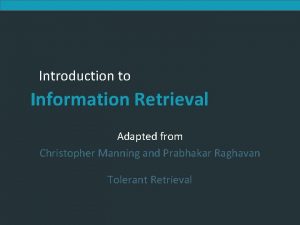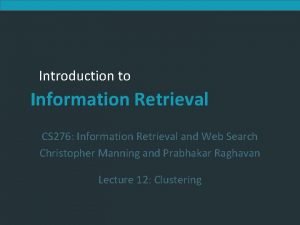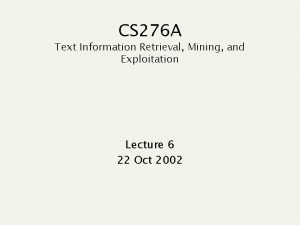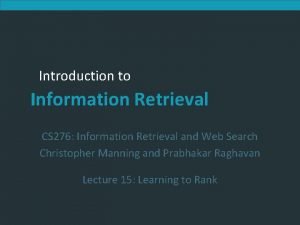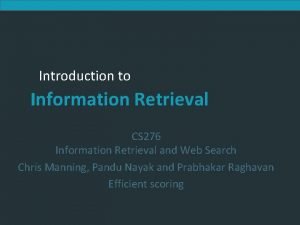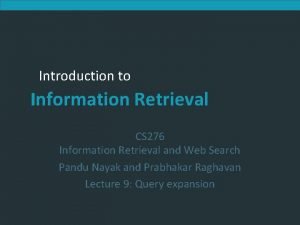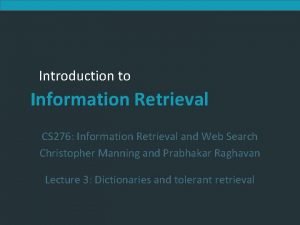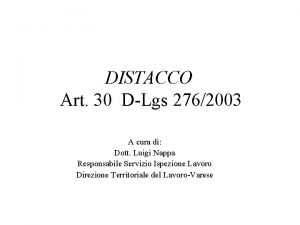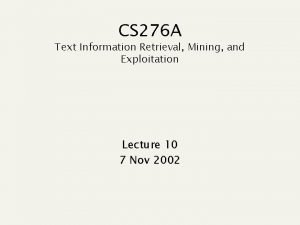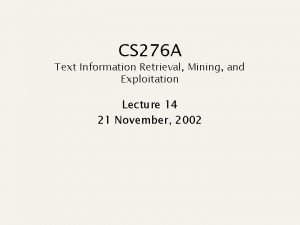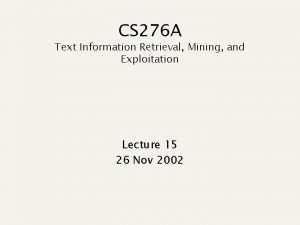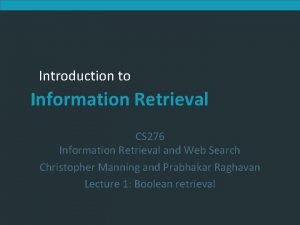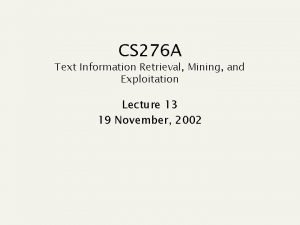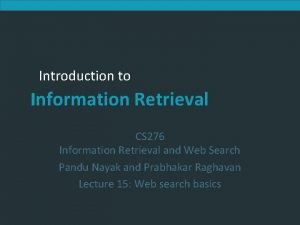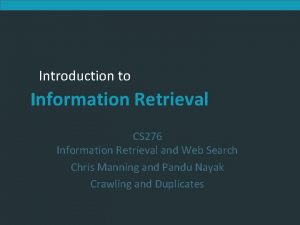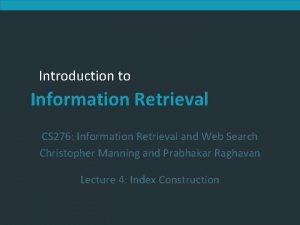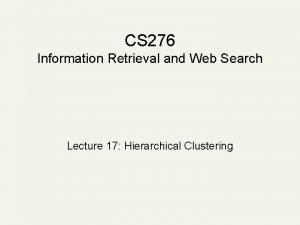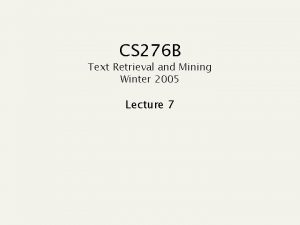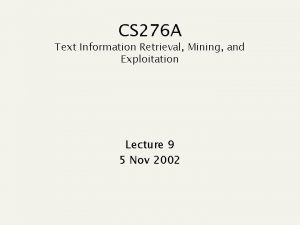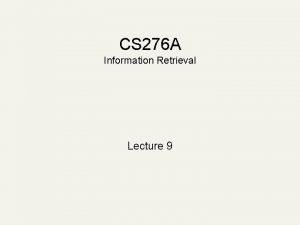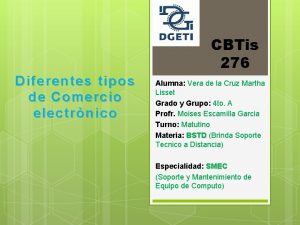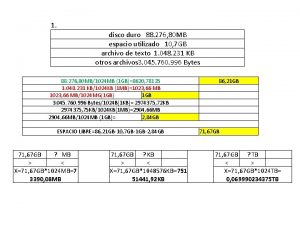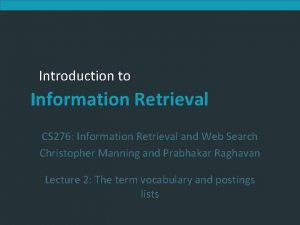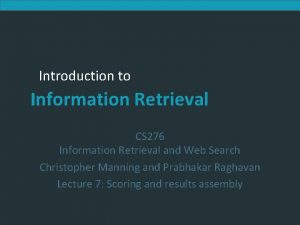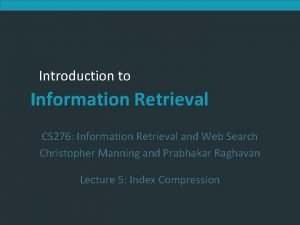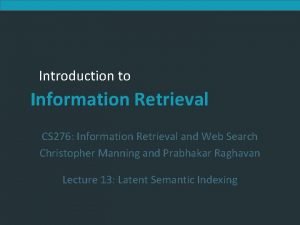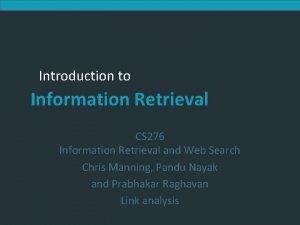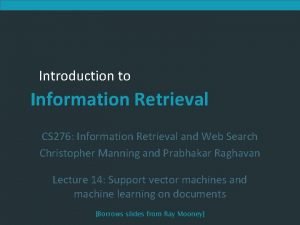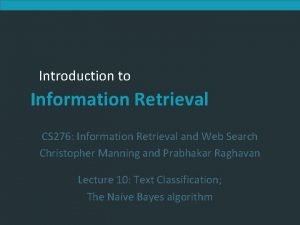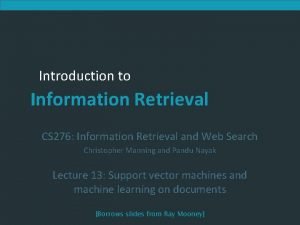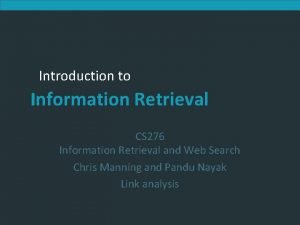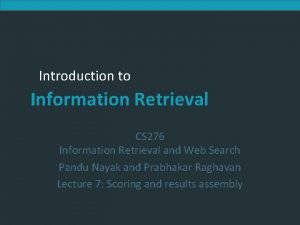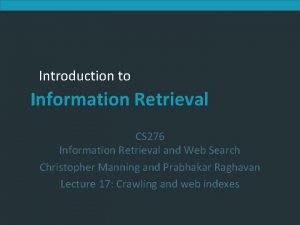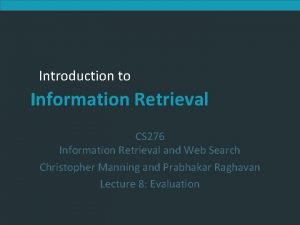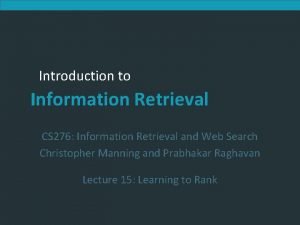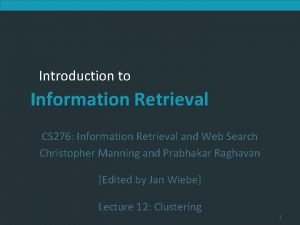Introduction to Information Retrieval CS 276 Information Retrieval



































- Slides: 35

Introduction to Information Retrieval CS 276: Information Retrieval and Web Search Christopher Manning and Prabhakar Raghavan Lecture 2: The term vocabulary and postings lists

Introduction to Information Retrieval Relembrando…. Documentos para indexar. Friends, Romans, countrymen. Tokenizer Token Friends Romans Linguistic modules Tokens modificados. Indices Invertidos. friend roman Countrymen countryman Indexer friend 2 4 roman 1 2 countryman 13 16

Introduction to Information Retrieval Analisando um documento § Problemas de um documento § Qual o formato? § Existem diversos formatos; § pdf/word/excel/html. § Qual a língua? § Diversidade das línguas. § Quais os conjuntos de caracteres e usado? Sec. 2. 1

Introduction to Information Retrieval Operações sobre texto § Fases § Análise léxica § Elimina dígitos, pontuação, etc § Eliminação de stopwords § Artigos, pronomes, etc § Operação de stemming § Redução da palavra ao seu radical

Introduction to Information Retrieval TOKENS

Introduction to Information Retrieval Tokenization § Input: “Friends, Romans and Countrymen” § Output: Tokens § Friends § Romans § Countrymen § Quais os tokens são validos? Sec. 2. 2. 1

Introduction to Information Retrieval Sec. 2. 2. 1 Tokenization § Problemas na tokenization: § Finland’s capital Finland? Finlands? Finland’s? § Hewlett-Packard Hewlett and Packard tem dois tokens? § Como fazer com os hífens? § state-of-the-art § co-education § San Francisco: um token ou dois? § Como decidir a quantidade de tokens?

Sec. 2. 2. 1 Introduction to Information Retrieval Números § § § 3/20/91 Mar. 12, 1991 55 B. C. B-52 My PGP key is 324 a 3 df 234 cb 23 e (800) 234 -2333 20/3/91

Introduction to Information Retrieval Tokenization: Problemas das línguas § Frances § L'ensemble one token or two? § L ? L’ ? Le ? § Alemão § Lebensversicherungsgesellschaftsangestellter Sec. 2. 2. 1

Introduction to Information Retrieval Tokenization: Problemas das línguas § Língua arábica Sec. 2. 2. 1

Introduction to Information Retrieval Stop words § Palavras que não acrescentam semântica na sentença, com isso podem ser eliminadas; § Exemplo língua inglesa: the, a, and, to, be § Existe uma tabela padronizada de acordo com a língua. Sec. 2. 2. 2

Introduction to Information Retrieval Stop words: Tabela Português

Introduction to Information Retrieval Padronização dos termos § Tokenization depende da língua. § Padronizar as palavras na mesma forma: § § U. S. A. e USA tem o mesmo significado Acentos: e. g. , Francês résumé vs. resume. Tremas: e. g. , Alemão: Tuebingen vs. Tübingen Reduzir para letras minúsculas § Fed vs. fed § SAIL vs. sail § Retirar os hífens dos termos: § anti-discriminatory, antidiscriminatory Sec. 2. 2. 3

Sec. 2. 2. 3 Introduction to Information Retrieval Padronização dos termos § Exemplos: § Enter: windows § Enter: Windows Search: window, windows Search: Windows, window Search: Windows

Introduction to Information Retrieval Thesauri and soundex § Sinônimos e homônimos? § E. g. , classes equivalentes: § car = automobile color = colour § Nos podemos reescrever para formar classes equivalentes: § Quando um documento contem automobile, utilizamos o índice de carautomobile (e vice-versa) § Ou nos podemos expandir a consulta para: § Quando a consulta conter automobile, analisar car também. § Como lidar com os erros ortográficos? § Utilizar a técnica de soundex, o qual se baseia em heurísticas fonéticas. § Veremos detalhes nos capítulos 3 e 9

Introduction to Information Retrieval Sec. 2. 2. 4 Lemmatization § Reduzir formas variantes dos termos: § E. g. , § am, are, is be § car, cars, car's, cars' car § the boy's cars are different colors the boy car be different color

Introduction to Information Retrieval Sec. 2. 2. 4 Stemming § Reduzir os termos antes da indexação; § Reconhecer os padrões de formação das palavras; § Depende da língua; § Baseado em regras; § e. g. , automate(s), automatic, automation todos reduzidos para automat. for example compressed and compression are both accepted as equivalent to compress. for exampl compress and compress ar both accept as equival to compress

Sec. 2. 2. 4 Introduction to Information Retrieval Porter’s algorithm § Commonest algorithm for stemming English § Remocado dos sufixos das palvras; § Baseado em regras de acordo com a lingua; § Algoritmo procura pela maior sequencia de letras que casa com uma regra. § Exemplo: Termo engineering engineered engineer Stem engineer

Introduction to Information Retrieval Regras Algoritmo de Porter § § sses ss ies i ational ate tional tion § Regras dependem do tamanho da palavra § (m>1) EMENT → § replacement → replac § cement → cement Sec. 2. 2. 4

Introduction to Information Retrieval Sec. 2. 2. 4 Algoritmo Porter língua portuguesa

Introduction to Information Retrieval FASTER POSTINGS MERGES: SKIP POINTERS/SKIP LISTS

Sec. 2. 3 Introduction to Information Retrieval Relembrando a “merge” básico § Caminhamos por duas listas simultaneamente comparando o valor das listas, quando encontramos uma interseção adicionamos na lista de resultados. 2 8 2 4 8 41 1 2 3 8 48 11 64 17 Como podemos melhorar? 128 Brutus 21 31 Caesar

Sec. 2. 3 Introduction to Information Retrieval Query processing with skip pointers 41 2 11 1 4 2 8 3 128 41 8 48 31 11 64 17 128 21 31 Suponha que caminhamos nas duas listas ate achar a interseção entre elas (ex. 8) Nos então temos os valores 41 e 11. 11 e o menor. Como o topo do lista e 31 e o ponteiro da outra lista e 41 podemos entao “escapar” para final da lista.

Introduction to Information Retrieval PHRASE QUERIES AND POSITIONAL INDEXES

Introduction to Information Retrieval Consulta de frases § Queremos consultar uma frase § Exemplo: “stanford university” – como uma frase § For this, it no longer suffices to store only <term : docs> entries Sec. 2. 4

Introduction to Information Retrieval Sec. 2. 4. 1 Primeira solução: Biword indexes § Separamos pares dos termos contidos na frase e criamos um índice para cada par; § Exemplo do texto “Friends, Romans, Countrymen” podemos gerar as biwords § friends romans § romans countrymen § Cada uma das biwords é agora um termo do dicionário.

Introduction to Information Retrieval Sec. 2. 4. 1 Consultar frases longas § Dividimos a frases em Biwords e aplicamos a consulta booleana; § Exemplo: “stanford university palo alto “ Aplicando o conceito acima temos: stanford university AND university palo AND palo alto

Introduction to Information Retrieval Sec. 2. 4. 1 Extended biwords § Dividimos os termos em Nomes (N) e artigos/preposições (X). § Chamamos uma string de terms NX*N como uma extended biword. § Cada extended biword é um novo termo no dicionario. § Exemplo: catcher in the rye N X X N § Processo de consulta: analisá-lo em N’s and X’s § Consulta pelo índice: catcher rye

Introduction to Information Retrieval Sec. 2. 4. 1 Problemas para biword indexes § Dicionário de Índices muito grande § Inviável na pratica. § Biword índices não são a solução-padrão (para todos os biwords), mas pode ser parte de uma estratégia.

Introduction to Information Retrieval Solução 2: Positional indexes § Nas listas, armazenamos para cada termo a posição(ões) que aparecem no documento: <term, number of docs containing term; doc 1: position 1, position 2 … ; doc 2: position 1, position 2 … ; etc. > Sec. 2. 4. 2

Sec. 2. 4. 2 Introduction to Information Retrieval Positional index exemplo <be: 993427; 1: 7, 18, 33, 72, 86, 231; 2: 3, 149; 4: 17, 191, 291, 430, 434; 5: 363, 367, …> Aparecem nos docs 1, 2, 4, 5 Como consultar “to be or not to be”? § Be: aparece no documento 1 nas seguintes posições: 7, 18, 33, 72, 86, 231 § Mas agora precisamos lidar com mais do que apenas termos em comuns em documentos precisamos saber se estão próximos ou não.

Sec. 2. 4. 2 Introduction to Information Retrieval Recuperando uma frase § Extraímos o índice invertido para cada termo: to, be, or, not. § Merge das listas doc: position enumerando todas as posições com “to be or not to be”. § to: § 2: 1, 17, 74, 222, 551; § 4: 8, 16, 190, 429, 433; § 7: 13, 23, 191; . . . § be: § 1: 17, 19; § 4: 17, 191, 291, 430, 434; § 5: 14, 19, 101; . . . Em comum os documentos 4, em seguida analisar as posições: nesse exemplo temos mais próximos 429(to), 430(be) e 433(to), 434(be)

Introduction to Information Retrieval Sec. 2. 4. 2 Tamanho do índice por posição § Existem técnicas de compressão dos valores das posições, será discutido no capitulo 5. § Essa técnica aumenta substancialmente o espaço em disco necessário para armazenamento dos índices e posições. § Grande vantagem dessa técnica é o poder de buscar frases pela proximidade das palavras.

Introduction to Information Retrieval Sec. 2. 4. 2 Regras § Um índice por posição é de 2 a 4 vezes que um índice não posicional § Tamanho do índice por posição e de 35 a 50% do volume do texto original. § Obs. : Esses dados são baseados na língua inglesa.

Introduction to Information Retrieval Resources for today’s lecture § IIR 2 § MG 3. 6, 4. 3; MIR 7. 2 § Porter’s stemmer: http: //www. tartarus. org/~martin/Porter. Stemmer/ § Skip Lists theory: Pugh (1990) § § Multilevel skip lists give same O(log n) efficiency as trees H. E. Williams, J. Zobel, and D. Bahle. 2004. “Fast Phrase Querying with Combined Indexes”, ACM Transactions on Information Systems. http: //www. seg. rmit. edu. au/research. php? author=4 § D. Bahle, H. Williams, and J. Zobel. Efficient phrase querying with an auxiliary index. SIGIR 2002, pp. 215 -221.
 Introduction to information retrieval
Introduction to information retrieval Bvf document
Bvf document Introduction to information retrieval
Introduction to information retrieval Manning information retrieval
Manning information retrieval Cs 276
Cs 276 Cs 276
Cs 276 Cs-276
Cs-276 Wwhatsp
Wwhatsp Cs 276
Cs 276 Relevance information retrieval
Relevance information retrieval Fleas editing dictionary code
Fleas editing dictionary code Art 30 dlgs 276/03
Art 30 dlgs 276/03 Cs 276
Cs 276 Cs-276
Cs-276 Cs-276
Cs-276 Cs276 stanford
Cs276 stanford Cs 276
Cs 276 Psalm 276
Psalm 276 Item 356
Item 356 Cs 276
Cs 276 Cs 276
Cs 276 Cs 276
Cs 276 Cs 276
Cs 276 Cs 276
Cs 276 Cs 276
Cs 276 Cs 276
Cs 276 Cs 276
Cs 276 Cs 276
Cs 276 Cbtis 276
Cbtis 276 276 + 80
276 + 80 Ncbr limit 276 godzin
Ncbr limit 276 godzin Esercizi alternatore
Esercizi alternatore Cs 276
Cs 276 Cs 276
Cs 276 Cs 276
Cs 276 Cs 276
Cs 276

